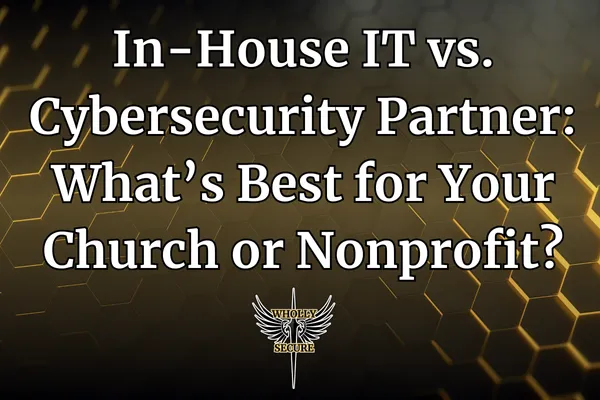
In-House IT vs. Cybersecurity Partner: What’s Best for Your Church or Nonprofit?
In-House IT vs. Cybersecurity Partner: What’s Best for Your Church or Nonprofit?
Many churches and nonprofits already have someone who “handles the tech.” It might be a full-time IT staffer, a volunteer, or a managed service provider (MSP). But when it comes to cybersecurity, is that enough?
In this article, we’ll walk through the difference between general IT support and a dedicated cybersecurity partner so you can decide what’s right for your organization.
What Does In-House or Managed IT Usually Cover?
An internal IT team or outsourced provider typically focuses on the following:
Device setup and maintenance
Software updates and patching
Wi-Fi networks and connectivity
Basic user support
General technology troubleshooting
They play a critical role in day-to-day operations and often serve as the first line of defense when something breaks.
But cybersecurity is a different discipline.
What a Cybersecurity Partner Brings to the Table
A cybersecurity firm focuses specifically on risk prevention, threat detection, and regulatory compliance. Their services often include:
Risk and vulnerability assessments
Written cybersecurity and compliance plans
Incident response planning
Staff cybersecurity training
Data protection strategies
Insurance and audit support
Alignment with regulatory standards (state, federal, insurance, donor-related)
Their job isn’t to fix a broken printer. It’s to prevent a ransomware attack from ever happening in the first place.
Key Differences
Let’s look at some core distinctions:
1. Focus
IT: Operational efficiency and support
Cybersecurity: Risk reduction and data protection
2. Tools and Certifications
IT teams often use general-purpose tools
Cybersecurity partners use monitoring, endpoint protection, and compliance-grade frameworks
3. Threat Detection
IT may only notice an issue after something goes wrong
Cybersecurity partners look for red flags before breaches occur
4. Documentation and Reporting
Cybersecurity services often include formalized reports for leadership, boards, and insurance carriers
IT documentation tends to be limited to ticketing systems and configurations
Can They Work Together?
Yes. In fact, they should.
Many churches and nonprofits have both — and that’s often the best-case scenario. Your IT team handles operations. Your cybersecurity partner provides oversight, planning, and support that reduces long-term risk.
If your IT team is open to collaboration, the results are often faster, more affordable, and more effective than choosing one or the other in isolation.
Final Word
You don’t have to choose between in-house IT and cybersecurity support. But you do need to know where the gaps are, and whether someone is focused on filling them.
A cybersecurity partner won’t replace your IT team. They’ll strengthen it.
Not sure what your current setup is missing?
Schedule a Free Discovery Call